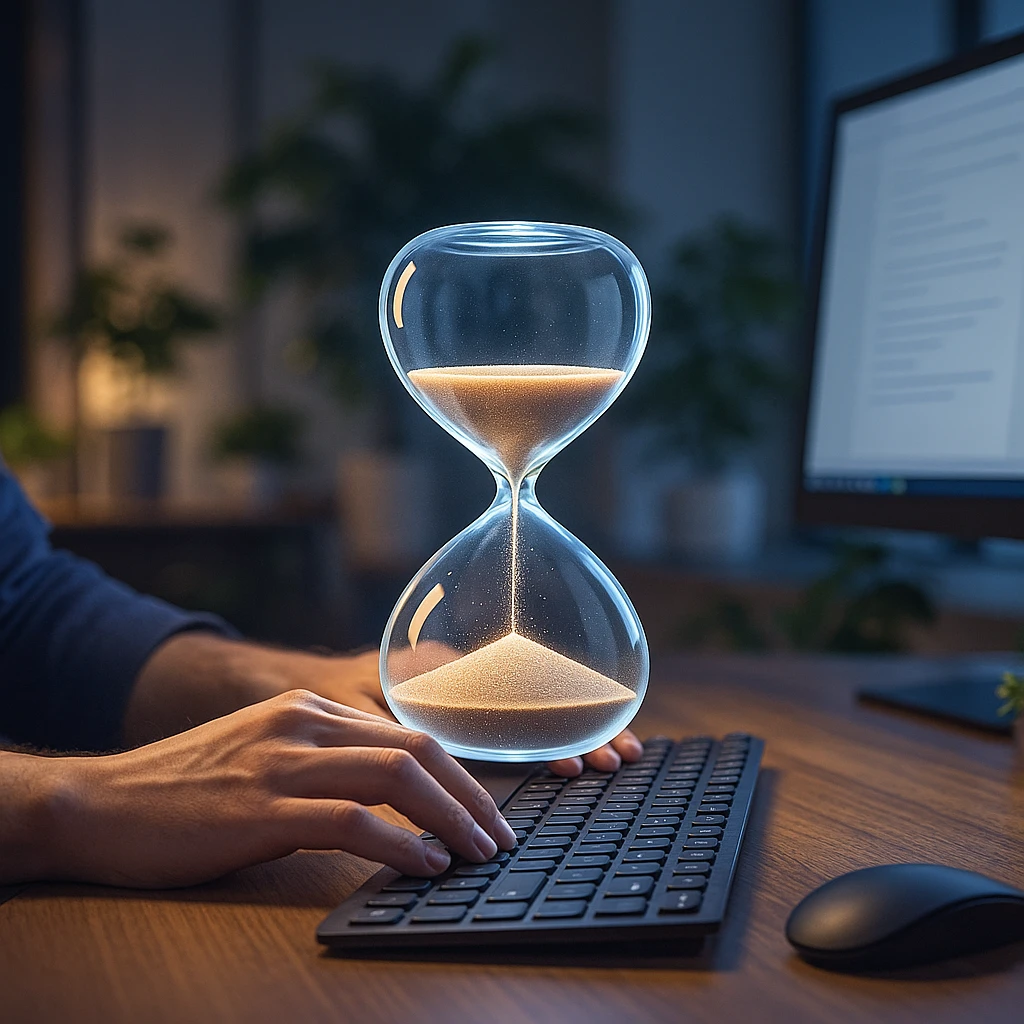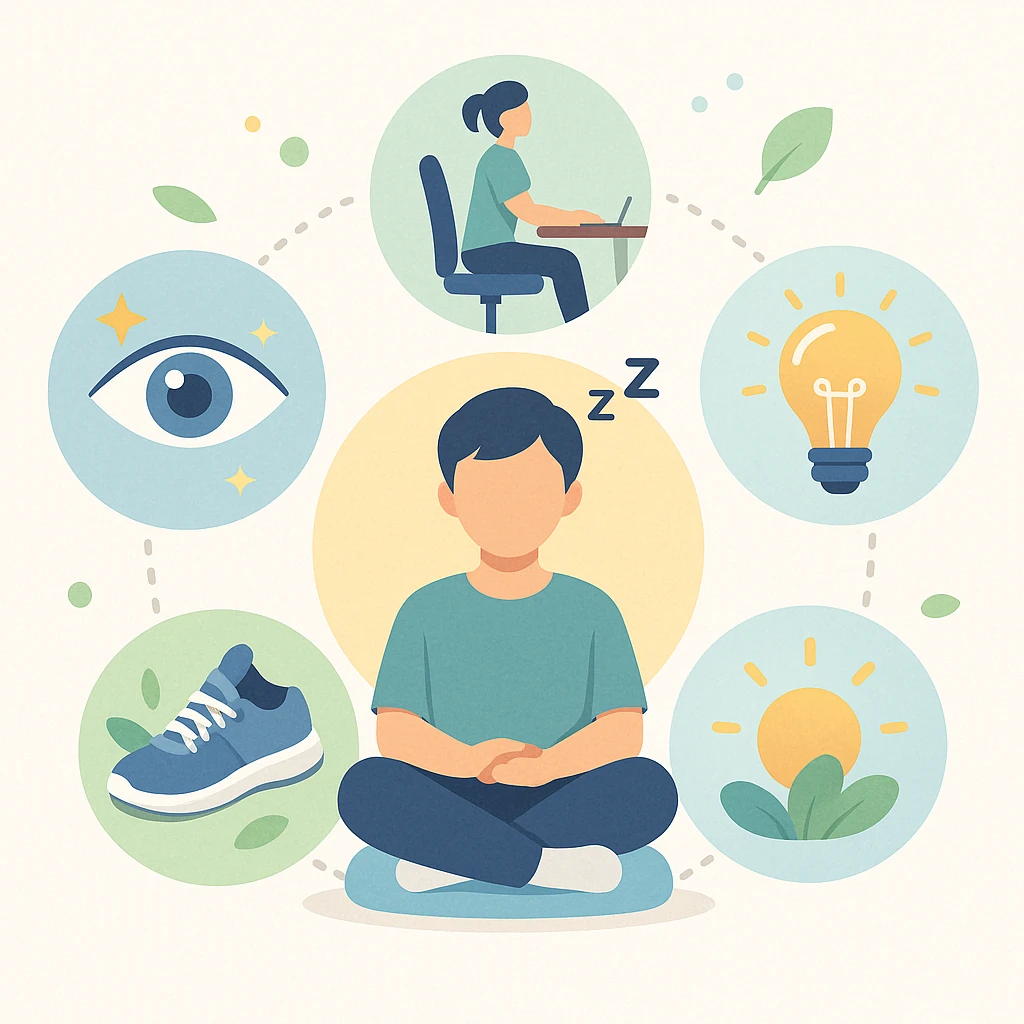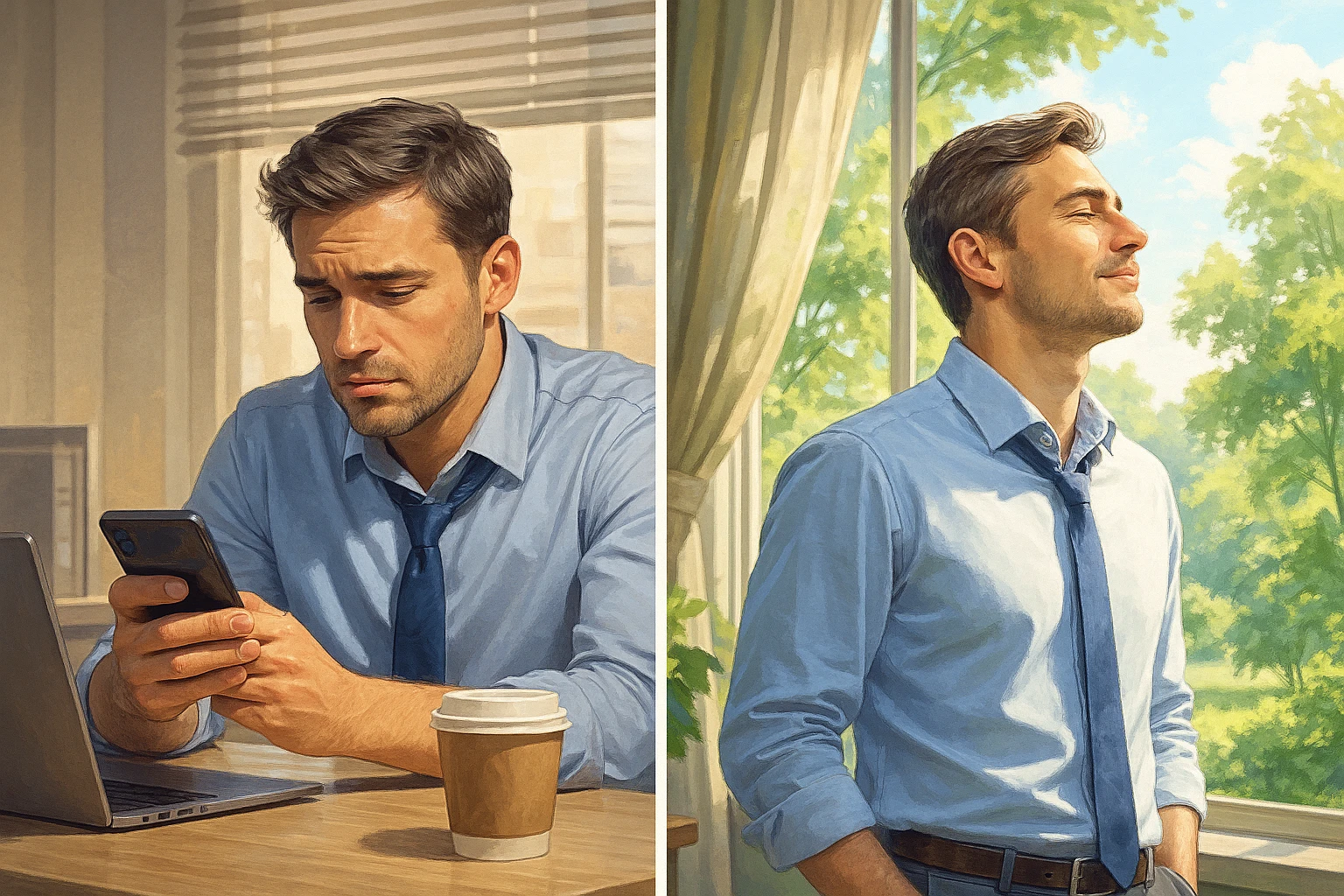Taking just a short break during work—how much of an impact can something that simple have? Recent studies show that short breaks of ten minutes or less, called “micro-breaks,” reduce fatigue and help restore motivation.
However, not all kinds of breaks work the same way. What you want to improve, when you take the break, and what you do during it—this three-part combination determines the effect.
In this article, we organize the latest findings on micro-breaks based primarily on published research. Rather than hunting for a “correct number of seconds,” we explain how to design breaks according to your goal, together with the evidence behind each recommendation.
What Are Micro‑Breaks?

A micro-break is a short break of ten minutes or less inserted in the middle of ongoing work.
Even break lengths commonly used in practice—60 to 180 seconds—have been shown to change how fatigued you feel and how focused you are.
The brain has limits to how much information it can process at one time. As you continue working, this processing capacity gradually gets depleted. Short breaks offer an opportunity to restore these depleted neural resources.
What We Know—and What’s Still Uncertain
A synthesis of 22 studies with data from 2,335 people showed that micro-breaks increase motivation and reduce fatigue. The effect sizes are small to medium, and the benefits appear fairly consistently regardless of differences in age, occupation, or task content.
By contrast, the impact on performance varies with the situation. Effects tend to appear more readily for simple tasks or creative tasks, and there is a tendency for performance to improve as breaks get longer. However, for difficult tasks, a break of ten minutes or less may not be enough to recover. In other words, there is still no one-size-fits-all answer like “rest N seconds and performance will always improve.”
A few newer findings have also been added recently.
In a university lecture experiment where a 90‑second micro-break was inserted every ten minutes, quiz accuracy declined less over time. Compared with the no‑micro‑break condition, the mid‑to‑late portion of the class showed a markedly smaller drop in scores.
There has also been research that prompts breaks in everyday life. After sitting continuously for 30 minutes, prompting participants to walk for 3 minutes improved feelings of mood and energy in the short term. This study detected sitting time with wearables and randomly encouraged breaks. It is novel in that it tested causal effects in conditions close to daily life.
Design Breaks by Objective

You need to change how you take micro-breaks depending on what you want to improve. Below we summarize recommended methods, their evidential bases, and cautions by objective.
Calibrate Motivation and Fatigue
If your goal is to reach the end of the workday feeling less “wiped out” and to keep motivation (in research terms, vigor) high, it’s effective to insert short pauses in response to your own signals.
Examples of signals: you find yourself rereading the same passage over and over / your gaze drifts away from the screen—when you notice small changes like these, mark a boundary with a micro-break of a few minutes. That alone is sufficient.
(Research defines micro-breaks as short breaks under ten minutes. In practice, 3–5 minutes or 9–10 minutes are often reported. Intervals of 1–3 minutes are also a practical range for real‑world use.)
The meta-analysis mentioned above also showed this effect. On days when more micro-breaks were taken, end‑of‑day fatigue was lower and vigor was higher.
That said, what you do during the break also affects how much you recover.
Break activities unrelated to work (a walk, stretching, a quick chat, exposure to nature) tend to be associated with the day’s immediate recovery.
Break activities related to work (organizing the next tasks, reflection, helping a colleague) can sometimes raise load in the moment, but repeated over time they may lead to long‑term benefits such as personal growth and improved social relationships through communication with colleagues and supervisors.
Combinations also matter. For example, pairing a movement‑based micro-break with light task triage has been reported to correlate with higher vigor.
Keep Learning
For lectures, training, and study where you want to sustain concentration for a long period, a method that inserts a 90‑second break every ten minutes has been demonstrated.
This method was tested in a psychology course at a UK university. Two hundred fifty‑three undergraduates took a 90‑minute seminar format class for ten weeks with the same instructor throughout. One group used the usual approach—one ten‑minute break after about 45 minutes. The other group took micro-breaks: 90‑second breaks every ten minutes. Testing showed that the micro‑break group’s quiz scores declined less over time than the no‑micro‑break group’s. The gap widened especially in the middle to latter parts of the class. frontiersin
Break content included light stretching, drinking water, closing the eyes, and brief conversation. Nothing complicated was required.
Another study showed that even just looking at greenery outside a window for 40 seconds can improve sustained attention.
However, for highly difficult tasks, longer breaks may be necessary. The relationship between task characteristics and break length has not yet been fully resolved.
Boost Mood and Energy Immediately
If you want to elevate your mood and sense of energy right now, walking for 3 minutes after you have been sitting for 30 minutes is effective.
A 2024 study tested this approach in everyday life. When sitting time reached 30 minutes, participants received random notifications to “walk.” After responding and walking, feelings of pleasant mood and energetic arousal increased.
What’s important here is walking, not merely standing up. The research suggests that light aerobic activity like walking is more effective than just standing up from a chair.
There are also indications that frequency and intensity matter more than sheer length. Instead of taking 180 seconds all at once, breaking it into three 60‑second bouts and moving a little each time might be more effective for mood and energy.
Note that in this study, there were no clear differences in cognitive functions such as working memory. One possibility is that participants’ baseline abilities were high and measures may have hit ceiling effects.
Relieve Eye Strain
Looking at a screen for a long time makes your eyes tired. The “20‑20‑20 rule” helps relieve this fatigue.
This is the method of looking at something about 6 meters away for 20 seconds every 20 minutes. It’s also recommended to blink deliberately.
From 2022 to 2023, clinical studies were published showing that this rule reduces subjective symptoms of eye strain. However, objective indicators such as tear quantity and blink quality showed limited improvement over the short term. In terms of symptom relief, it is still highly practical.
In addition, the UK Health and Safety Executive (HSE) updated its guidance in 2025 to recommend that people doing screen work take 5 to 10 minutes of off‑screen time per hour. The principle is short breaks at a high frequency.
Reduce Load on the Neck, Shoulders, and Arms
Working on keyboard‑heavy tasks like data entry for long periods places load on the neck, shoulders, and arms.
Field research conducted by the US National Institute for Occupational Safety and Health (NIOSH) in the early 2000s showed that adding micro-breaks reduced discomfort and eye strain without lowering productivity.
Specifically, insert one to two minutes of active breaks multiple times per hour. Stand up, move your shoulder blades, and extend your hips. Even this alone can reduce musculoskeletal load.
For work involving manual operations, there are reports that combining a one‑minute micro‑pause and stretching every ten minutes helps suppress fatigue while maintaining productivity.
What’s important is actually taking the breaks—that is, adherence. A policy is meaningless if it isn’t used.
What You Do During the Break Changes the Quality of Recovery

Beyond the break itself, the content of what you do during it makes a big difference in recovery quality. For example, Berigan & Pielage (2013) suggested that a break viewing natural scenes tends to be better for attention restoration than watching TV programs.
It has also been reported that a 7‑minute breathing practice brought significant reductions in perceived stress and stabilized emotion.
In short, the “stimuli and actions” during the break likely play a large role in determining recovery quality.
Practical Micro‑Break Techniques You Can Actually Use
Below are concrete procedures tailored to objectives—exactly when, what, and for how long to do them.
Technique 1: Breaks for Your Eyes
Every 20 minutes, look about 6 meters into the distance for 20 seconds. Blink deliberately during that time. Then return to the screen.
Technique 2: Breaks for Posture
Stand up. Retract and protract your shoulder blades and extend your hips. Take 30 to 60 seconds, then sit back down.
Technique 3: Breaks for Breathing
Inhale for 4 seconds, hold for 1 second, exhale for 6 seconds. Repeat this three times. This takes about 30 to 45 seconds.
Technique 4: Breaks to View Nature
Look out the window or look at natural imagery or wallpapers. Continue for about 40 to 90 seconds.
Technique E: Walking Break
After 30 minutes of sitting, walk for 3 minutes. Use this when you want to boost mood and energy immediately. If you want to lower blood glucose, walk for 5 minutes every 30 minutes.
When returning from a break to your task, decide in a single sentence what you will do next before you start. That helps reactivate attention.
When to Insert Breaks
There are two ways to decide when to take breaks: set them in advance or decide based on the situation.
For time‑bounded settings like meetings or lectures, it’s a good idea to build breaks in from the start—for example, a 90‑second break every ten minutes.
For individual work, an approach that inserts moderate breaks is effective. For instance, trigger a notification once you’ve been sitting for 30 minutes and make “walk 3 minutes” the default option. However, if you feel your focus is slipping before that, allow yourself to take the break earlier.
Of course, if it’s difficult to walk for 3 minutes once every 30 minutes, adjust to 1–2 minutes of walking, and tune the time and frequency so that you feel you truly took a break.
Common Misconceptions
Finally, let’s clear up some common misunderstandings about micro-breaks.
“Shorter is always better.” Not necessarily. When you are working on difficult tasks, you may need somewhat longer breaks. It helps to keep task characteristics and break length aligned.
“Just standing is enough.” Not if your goal is to improve mood and energy. Light activity such as walking is more effective.
“Taking a quick look at social media = recovery.” Social media can give you a psychological sense of detachment from work, but the quality of recovery is questionable. Viewing nature tends to produce higher‑quality recovery.
“It will worsen sleep.” You don’t need to worry. Breaking up sitting time with light activity has been shown not to adversely affect sleep architecture.
Frequently Asked Questions
Q. What length is best for a micro‑break? Is there a “correct number of seconds”?
A. There is no universal correct answer. In the literature, micro-breaks are defined as short rests of ten minutes or less, and maintaining vigor (motivation) and reducing fatigue is consistently significant, but effects on performance vary with the task and with the length and content of the break. In practice, when you notice your signals, take a 60–180 second micro‑pause; if your goal is metabolism or a mood shift, use 3–5 minutes of walking, selecting by purpose. Even simply engaging with nature for 40 seconds (images or video) has shown micro‑break effects.
Q. Do ultra‑short breaks like “90 seconds every ten minutes” really help learning and concentration?
A. In real university classes, the group that inserted about 90 seconds every ten minutes showed smaller slowdowns and greater consistency in quiz scores than the usual‑break group. The best way is to try it yourself and see what effects you experience.
Q. Is it okay to glance at social media during a break?
A. It can provide a sense of detachment, but fatigue recovery tends to be incomplete, and micro‑breaks that involve viewing nature are generally more advantageous in experiments. When in doubt, make “engage with nature” your default.
Q. Is the 20‑20‑20 rule sufficient for eye strain? What’s the evidence?
A. The 20‑20‑20 rule—every 20 minutes, look about 6 meters away for 20 seconds—has trials showing it reduces subjective symptoms (digital eye strain and dry eye). On the other hand, some reviews judge the evidence limited, so it’s prudent not to over‑rely on it.
Q. Won’t increasing short breaks lower productivity?
A. Multiple studies indicate “no decrease,” and in some cases “maintenance or improvement.”
Summary
Micro‑breaks have consistently been shown to boost motivation and reduce fatigue. Meanwhile, their impact on task performance varies with task characteristics, break length, and what you do during the break.
Look at nature, walk, rest your eyes, change your posture, regulate your breathing—cycle through these activities briefly, and become sensitive to the signals that tell you it’s time for a break. That is the key to practical use.
At the organizational level, it’s recommended to embed the principle of short, frequent breaks into the culture of work. Effectiveness can be verified using both subjective feelings and objective indicators.
In line with this way of thinking about micro‑breaks, we also make available—free for anyone—an app that lets you practice the Flowtime technique, which automatically calculates break time according to working time while maintaining concentration. Try it from the Home page.
References
- Albulescu P, et al. (2022). "Give me a break!" A systematic review and meta-analysis on the efficacy of micro-breaks for increasing well-being and performance. PLOS ONE
- Albulescu P, et al. (2025). Short Breaks During the Workday and Employee-Related Outcomes: A Multilevel Daily Diary Study. Psychological Reports
- Sustaining student concentration: the effectiveness of micro-breaks in university lectures (2025). Frontiers in Psychology
- Causal effects of sedentary breaks on affective and cognitive parameters in daily life: a within-person encouragement design (2024). npj Mental Health Research
- Dose-Response Analysis of a Randomized Crossover Trial: Breaking Up Sitting Time with Physical Activity (2023). Medicine & Science in Sports & Exercise
- The effects of breaks on digital eye strain, dry eye and binocular vision (2022/2023). Contact Lens and Anterior Eye
- UK Health and Safety Executive (HSE). Working safely with display screen equipment – Work routine (2025)
- NIOSH. Strategic Rest Breaks Reduce VDT Discomforts Without Impairing Productivity (2000)
- The impact of breaking up prolonged sitting with physical activity on sleep during simulated night and day shift work (2025). Scientific Reports
- 40-second green roof views sustain attention: The role of micro-breaks in attention restoration (2015). Journal of Environmental Psychology
- The impact of hedonic social media use during work breaks on recovery experiences and return to task performance (2024). Scientific Reports
